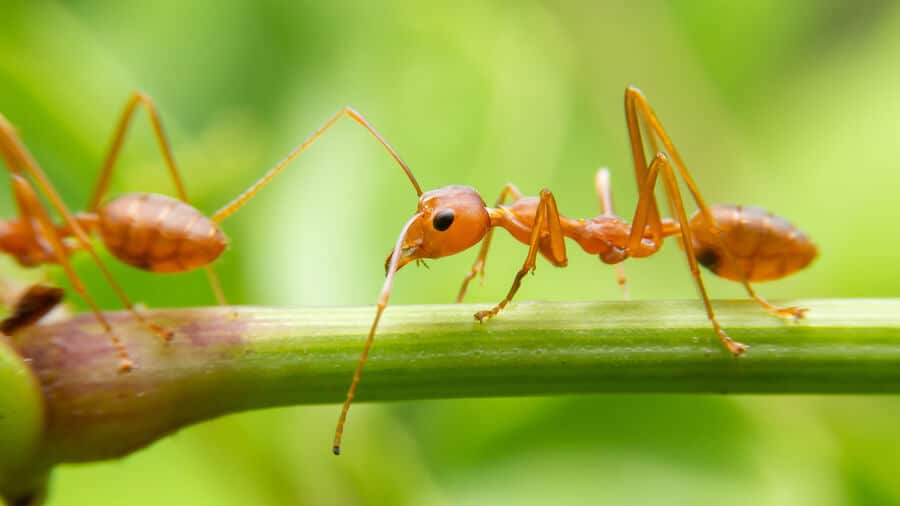Welcome to Michigan, a state known for its stunning landscapes, picturesque lakes, and vibrant natural beauty. As residents of this great state, we have the privilege of experiencing the changing seasons, enjoying outdoor activities, and immersing ourselves in the wonders of nature. However, along with the beauty of Michigan comes an array of common pests that can disrupt our lives and potentially pose risks to our homes and well-being.
In this comprehensive blog post, we will delve into the most prevalent pests found in Michigan, exploring their potential dangers, the destruction they can cause, and effective prevention methods to keep them at bay. By understanding the nature of these pests and equipping ourselves with the knowledge to prevent infestations, we can safeguard our homes, protect our families, and maintain a pest-free environment.
Michigan’s diverse climate, with its hot summers and cold winters, provides a favorable habitat for a wide range of pests. From tiny invaders to elusive creatures, these unwelcome guests can invade our living spaces, contaminate our food, damage our property, and even pose health risks. However, with proper awareness, education, and proactive measures, we can effectively manage and prevent these pest-related problems.
In the following sections, we will take an in-depth look at the most common pests encountered in Michigan, discussing their characteristics, potential dangers, and the havoc they can wreak if left unchecked. We will also provide valuable insights and practical tips to help you prevent infestations and protect your home.
Whether you’re a homeowner, renter, or business owner, this blog post aims to empower you with the knowledge and tools to effectively combat and prevent pest issues. By implementing preventive measures and understanding the importance of early detection, you can maintain a clean, safe, and pest-free environment.
So, join us as we explore the fascinating world of Michigan’s common pests. Together, let’s uncover their secrets, learn how to defend our homes, and discover the peace of mind that comes with living in a pest-free Michigan.
Note: For a more comprehensive guide to each specific pest, continue reading as we dive into the individual profiles of the most common pests found in Michigan. Use the Table of Contents below to skip ahead to the specific pest you want to learn about.
Ants

Ants are some of the most common pests encountered in Michigan homes. While they may seem harmless, ants can become a persistent nuisance once they establish colonies inside your living spaces. The most prevalent ant species in Michigan include pavement ants, carpenter ants, and odorous house ants.
Pavement ants are small, dark brown or black ants that typically nest in cracks or gaps in pavement, hence their name. They can enter homes in search of food, often attracted to sugary substances and crumbs. While pavement ants do not cause structural damage, their presence can be unsightly and frustrating.
On the other hand, carpenter ants can pose a more significant threat. These larger ants, typically black or reddish-brown, are known for their ability to excavate wood to build their nests. Unlike termites that feed on wood, carpenter ants tunnel through it, which can weaken the structural integrity of your home over time. If you notice large black ants indoors, particularly near wooden structures, it’s crucial to take prompt action to prevent further damage.
Odorous house ants are small brown ants that emit a distinctive, unpleasant odor when crushed. They are attracted to a wide range of food sources and can quickly establish colonies in your kitchen or pantry. While they do not cause structural damage, their presence can contaminate food and create a sanitation concern.
To prevent ant infestations, it’s important to eliminate their food sources and seal potential entry points. Regularly clean up crumbs and spills, store food in airtight containers, and ensure garbage bins are tightly sealed. Additionally, inspect and seal any cracks or gaps in your home’s foundation, windows, and doors, as ants can exploit even the tiniest openings.
If you suspect a carpenter ant infestation or notice signs of wood damage, it’s advisable to seek professional pest control services. Trained technicians can identify the extent of the infestation, locate the nest, and implement targeted treatments to eliminate the problem.
Remember, early prevention and swift action are key when dealing with ant infestations. By staying vigilant and implementing proper sanitation practices, you can effectively deter ants from invading your home and protect its structural integrity.
Powder Post Beetles
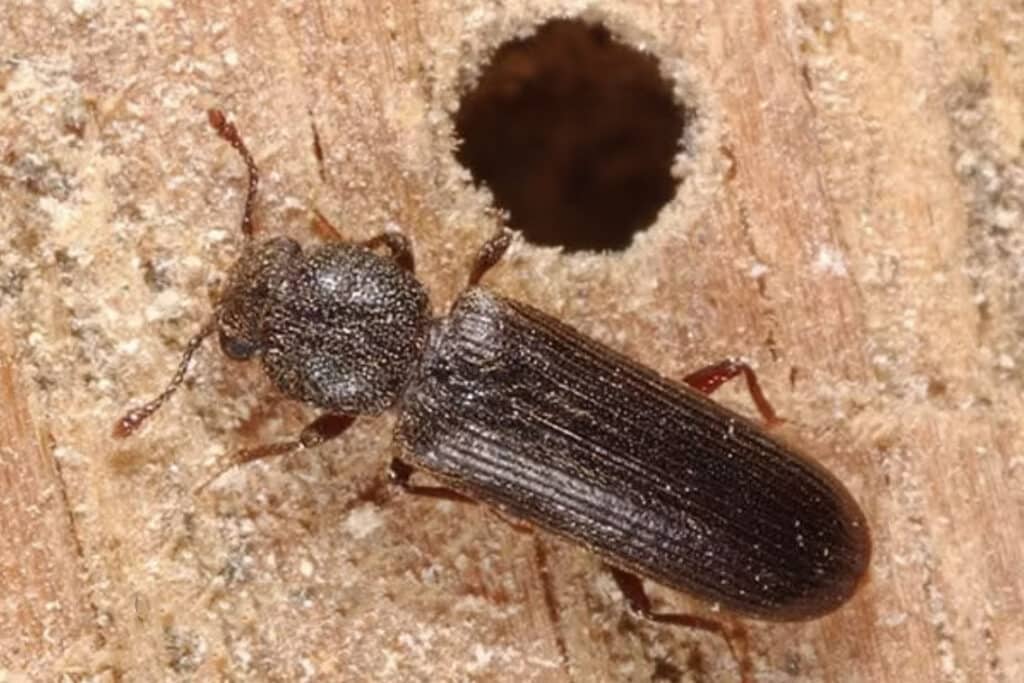
Powder post beetles are wood-boring insects that can cause significant damage to wooden structures and furniture. These small, reddish-brown beetles are named after the fine, powdery frass (wood dust) they leave behind as they tunnel through the wood.
In Michigan, the most common types of powder post beetles are the Anobiidae and Lyctidae species. Anobiidae beetles are often referred to as “furniture beetles” because they infest and damage wooden furniture, flooring, and structural timbers. Lyctidae beetles, known as “true powder post beetles,” primarily attack hardwoods, including oak, ash, and hickory.
The life cycle of powder post beetles begins when adult beetles lay their eggs on or inside cracks, crevices, or pores of unfinished wood surfaces. Once the eggs hatch, the larvae bore into the wood, where they spend several months to several years feeding and tunneling. It is during this larval stage that the most significant damage to the wood occurs.
The signs of a powder post beetle infestation include small holes in the wood surface, fine powdery frass, and weakened or crumbly wood. The damage caused by powder post beetles can compromise the structural integrity of wooden items, leading to costly repairs or replacements.
To prevent powder post beetle infestations, it’s essential to take precautions when bringing wood into your home. Inspect wooden furniture, flooring, and other wood items for any signs of beetle activity or damage. Avoid purchasing second-hand furniture without thorough inspection, as it may already be infested. Ensure that firewood is stored away from your home and off the ground, as it can harbor beetles.
If you suspect a powder post beetle infestation, it’s advisable to consult a professional pest control service. They have the expertise to identify the extent of the infestation, locate hidden larvae or eggs, and recommend appropriate treatment methods. In some cases, fumigation or localized treatments may be necessary to eliminate the infestation completely.
Regular maintenance and upkeep of wooden structures are also crucial in preventing powder post beetle problems. Keep wood properly sealed or finished to minimize vulnerabilities, repair any cracks or gaps in wooden surfaces, and maintain adequate ventilation to reduce moisture levels, as high moisture content can attract powder post beetles.
By staying proactive and addressing potential powder post beetle issues promptly, you can protect your valuable wooden possessions and preserve the beauty and integrity of your home.
Carpet Beetles
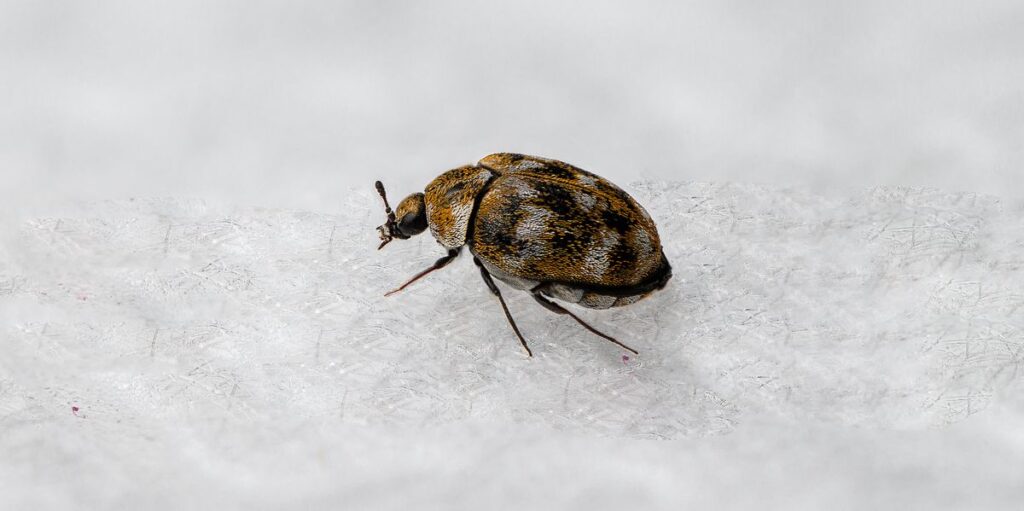
Carpet beetles are small, oval-shaped insects that can cause damage to various household items, including carpets, upholstery, clothing, and stored food products. They are attracted to natural fibers, such as wool, silk, fur, and feathers, which serve as their primary food source.
In Michigan, the most common types of carpet beetles are the varied carpet beetle, furniture carpet beetle, and black carpet beetle. These beetles are typically small and range in color from black to brown, with varied carpet beetles exhibiting colorful scales on their wings.
Carpet beetles have a life cycle consisting of four stages: egg, larva, pupa, and adult. It’s during the larval stage that they cause the most damage. The larvae are small, hairy, and often referred to as “woolly bears.” They actively feed on natural fibers, causing holes, irregular patterns, or thinning in carpets, rugs, and clothing.
Preventing carpet beetle infestations involves several key steps. Regular vacuuming is crucial, especially in areas where carpet beetles are likely to hide, such as along baseboards, under furniture, and in storage areas. Vacuuming helps to remove eggs, larvae, and adult beetles, minimizing their population.
Proper storage practices also play a significant role in preventing carpet beetle infestations. Store clothing, blankets, and other textiles in sealed plastic containers or garment bags to prevent access to carpet beetles. It’s also important to regularly inspect and clean stored items, as carpet beetles can infest and multiply if left unchecked.
Maintaining cleanliness and good hygiene in your home is essential. Regularly launder clothing and fabrics, paying attention to items that are susceptible to carpet beetle damage. Keep areas free from food debris and ensure that spills and crumbs are promptly cleaned up, as even small food particles can attract carpet beetles.
If you suspect a carpet beetle infestation or notice signs of damage, professional pest control services can assist in identifying the source and extent of the infestation. They can recommend appropriate treatment methods, such as targeted insecticide applications, to eliminate carpet beetles and prevent further damage.
By implementing these preventive measures and maintaining a clean environment, you can minimize the risk of carpet beetle infestations and protect your belongings from their destructive feeding habits.
Centipedes
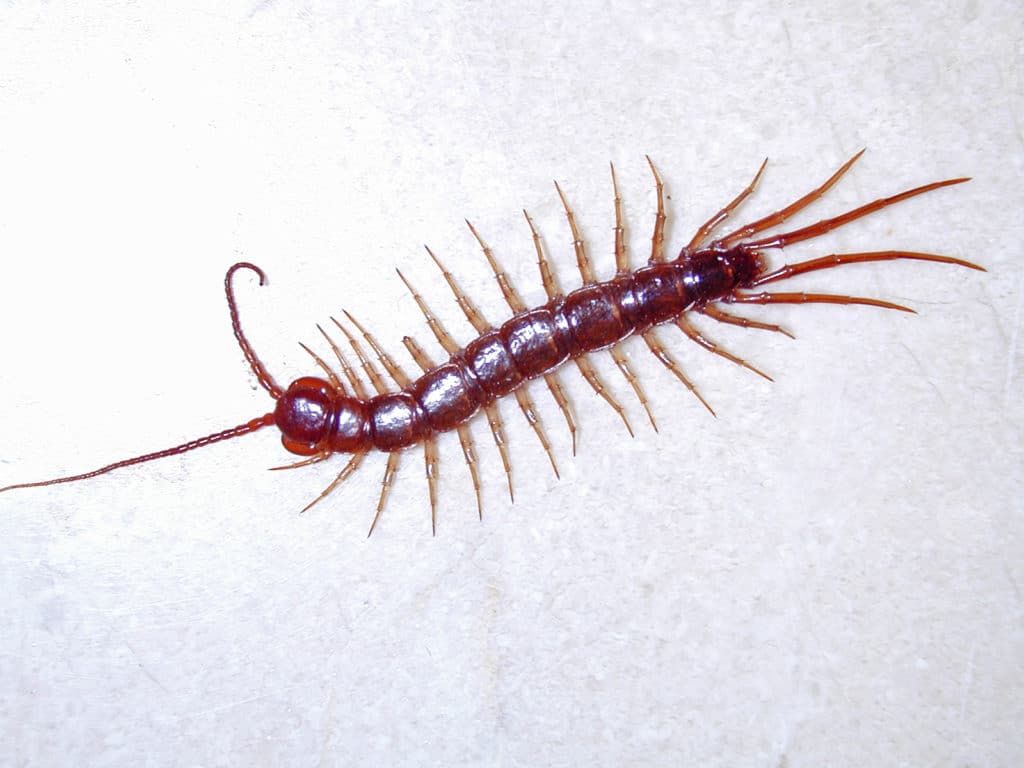
Centipedes are arthropods with long, segmented bodies and numerous legs. While their appearance may be unsettling, centipedes are actually beneficial creatures that help control other pests, such as spiders and insects. However, when they find their way inside homes, centipedes can become a source of concern for homeowners.
In Michigan, the most common types of centipedes include the house centipede and the stone centipede. House centipedes are pale yellow or grayish-brown with numerous long legs and antennae. They are fast-moving and often found in damp areas like basements, bathrooms, and crawlspaces. Stone centipedes, on the other hand, are typically brown or reddish-brown with shorter legs and are commonly found in gardens and outdoor environments.
Centipedes prefer moist environments and are typically attracted to areas with high humidity levels. They feed on small insects, spiders, and other arthropods, making them beneficial for controlling other pests. However, their presence indoors can be alarming for some individuals.
To prevent centipedes from entering your home, it’s important to address moisture issues and create a less inviting environment for them. Ensure proper ventilation in basements, crawlspaces, and bathrooms to reduce humidity levels. Fix any leaks or water seepage problems that may contribute to dampness. Additionally, declutter areas where centipedes may hide, such as piles of debris, stored items, or excessive vegetation near the foundation.
Sealing entry points is another effective way to keep centipedes out of your home. Inspect the exterior of your house for cracks, gaps, or holes, and seal them with caulk or other appropriate materials. Pay special attention to areas around windows, doors, vents, and utility penetrations.
If you find centipedes inside your home, it’s important to remember that they are not harmful to humans and do not cause structural damage. However, if their presence becomes a nuisance or an infestation is suspected, professional pest control services can assist in assessing the situation and implementing appropriate control measures.
In conclusion, while centipedes may startle homeowners with their appearance, they play a beneficial role in the ecosystem by preying on other pests. By addressing moisture issues, reducing humidity, and sealing entry points, you can discourage centipedes from entering your home and maintain a comfortable living environment.
Earwigs
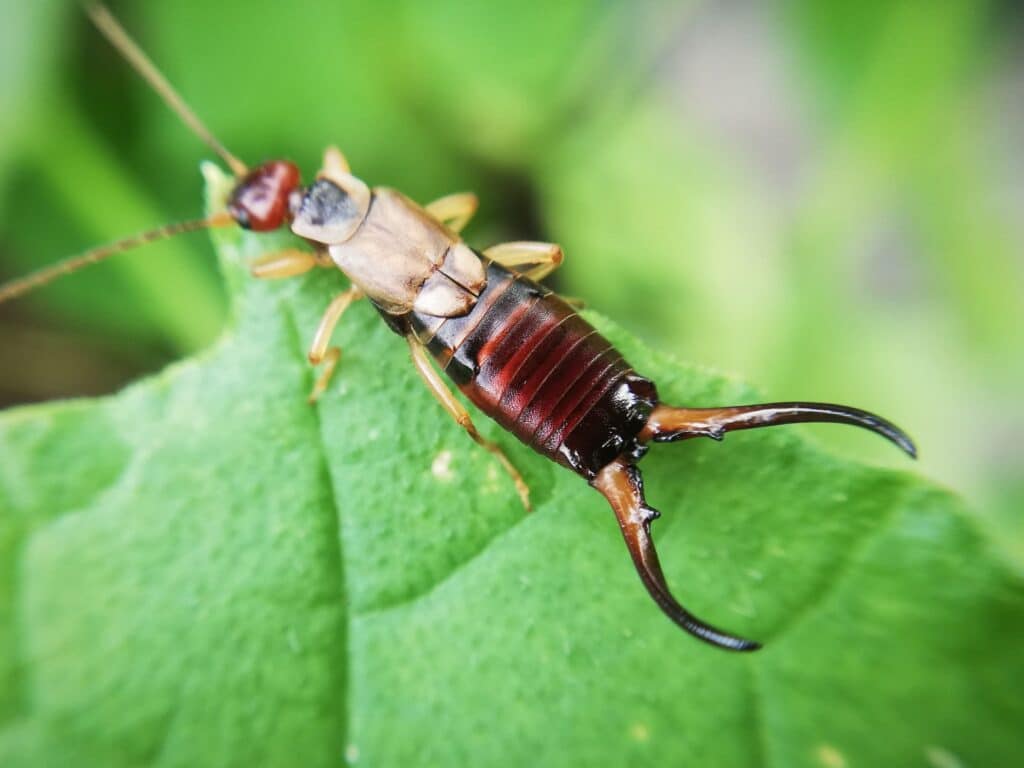
Earwigs are small, elongated insects with distinctive pincers or forceps-like appendages at the rear of their bodies. Despite their intimidating appearance, earwigs are generally harmless to humans and pets. They are nocturnal creatures that prefer dark, moist environments and can often be found in gardens, mulch beds, and damp areas around homes.
In Michigan, the most common species of earwigs is the European earwig. These reddish-brown insects have a flattened body and can grow up to 0.75 inches in length. Earwigs primarily feed on organic matter, including decaying plant material, algae, fungi, and small insects. While they are not known to cause significant damage to structures or crops, they can occasionally nibble on leaves, flowers, or fruits.
During the day, earwigs seek shelter in cool, damp places such as cracks, crevices, and under rocks or logs. However, they can accidentally enter homes through openings in doors, windows, or gaps in the foundation. While earwigs are more commonly found outdoors, their presence indoors can be unsettling for homeowners.
To prevent earwigs from entering your home, it’s important to eliminate their preferred habitats and seal potential entry points. Start by removing debris, leaf litter, and excess mulch from around the perimeter of your home, as these provide ideal hiding spots for earwigs. Trim vegetation away from the foundation and create a dry, well-ventilated environment to discourage their presence.
Sealing cracks and gaps in your home’s exterior can help prevent earwig entry. Pay attention to areas around doors, windows, pipes, vents, and utility lines. Use caulk or weatherstripping to seal any openings that could serve as potential access points.
If you notice earwigs inside your home, it’s best to employ non-chemical control methods first. Vacuuming them up or using sticky traps can help reduce their numbers. Avoid squashing earwigs, as they may release a foul odor as a defense mechanism.
In cases where earwig infestations persist or become overwhelming, professional pest control services can provide effective solutions. Pest control professionals can assess the extent of the infestation, identify entry points, and recommend targeted treatments to manage the problem.
By implementing these preventive measures and taking prompt action if an infestation occurs, you can minimize the presence of earwigs in and around your home, ensuring a more comfortable living environment.
Clover Mites
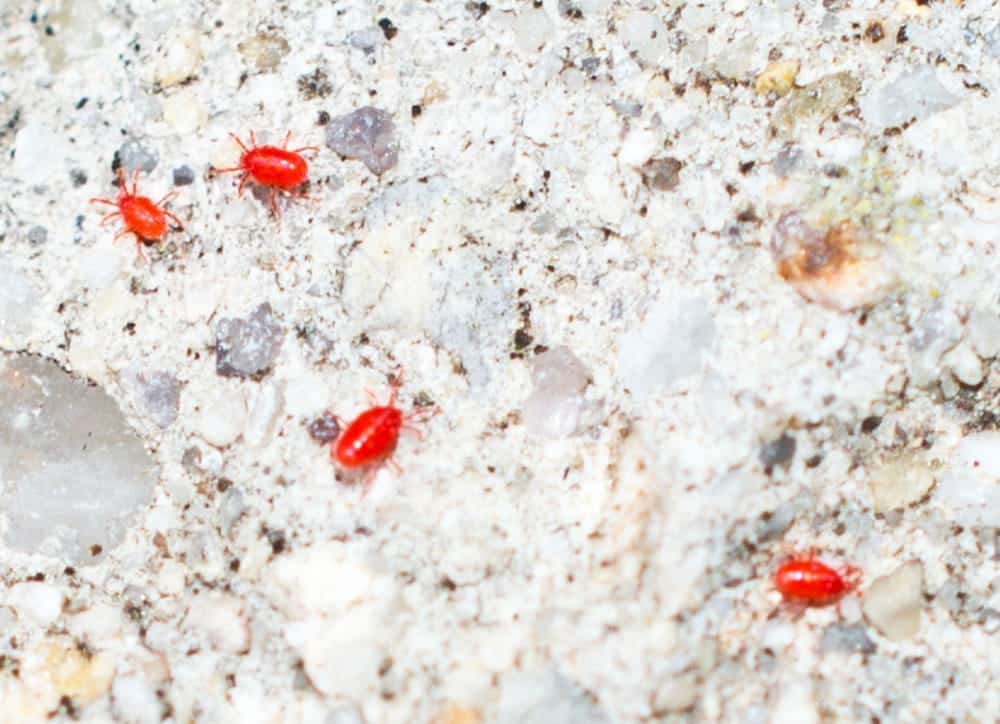
Clover mites are tiny, reddish-brown arachnids that are commonly found in Michigan. They are often mistaken for insects due to their small size and six legs, but they are actually close relatives of spiders and ticks. Clover mites are harmless to humans and pets, but their presence can be a nuisance, especially when they invade homes in large numbers.
These minuscule pests are commonly found in areas with lush vegetation, such as lawns, gardens, and fields. They feed on plant sap, particularly from clover, grass, and other plants. While they do not cause damage to structures or harm humans or pets, their high reproductive rate and tendency to gather in large groups can make them an annoyance.
Clover mites become more active during the cooler months of spring and fall, seeking shelter and warmth. They often enter homes through tiny cracks and gaps in foundations, siding, and windowsills. Once inside, they are typically found on windowsills, walls, curtains, and other surfaces near windows. Their presence can be easily noticed by their distinctive red color and their ability to leave behind red stains when crushed.
To prevent clover mites from entering your home, it’s important to seal any potential entry points. Inspect the exterior of your home for cracks, gaps, and openings and seal them with caulk or weatherstripping. Pay attention to areas around windows, doors, utility penetrations, and foundation vents. Keeping a well-maintained and clutter-free yard can also help reduce their population.
If you find clover mites inside your home, it’s best to avoid crushing them, as they can leave behind red stains on surfaces. Instead, use a vacuum cleaner to remove them carefully. Empty the vacuum bag or canister promptly to prevent the mites from escaping and reinfesting your home.
While clover mites are not a serious threat, professional pest control services can help if their presence becomes overwhelming or persistent. Pest control professionals can assess your home, identify entry points, and provide effective treatment options to manage the clover mite population.
By implementing these preventive measures and taking prompt action if an infestation occurs, you can minimize the presence of clover mites in and around your home, ensuring a more comfortable living environment.
Spiders
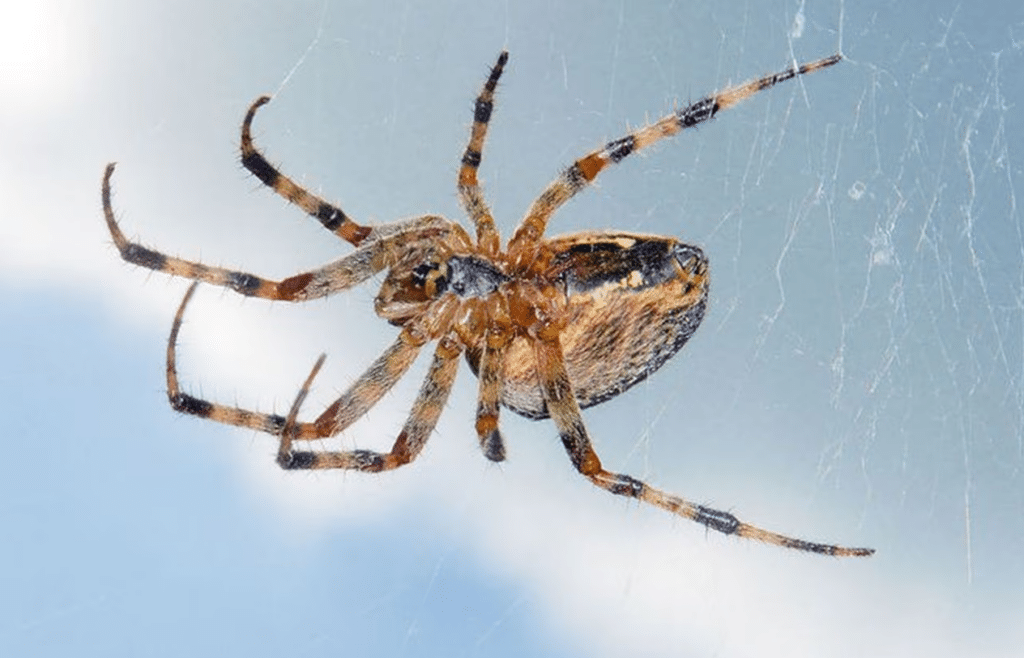
Spiders are a common sight in Michigan, and while most species are harmless, their presence can cause unease for many homeowners. Spiders are arachnids with eight legs and two body segments: the cephalothorax and the abdomen. They play an essential role in controlling other insect populations, making them beneficial in maintaining a balanced ecosystem.
Spiders primarily feed on insects, helping to control populations of other pests. However, their presence indoors can be undesirable for many homeowners. To reduce the likelihood of spider infestations, it’s important to take preventive measures:
- Keep your home clean and clutter-free. Regularly vacuum corners, closets, and other secluded areas where spiders may build webs.
- Seal cracks and gaps in doors, windows, and the foundation. This helps to prevent spiders from entering your home in the first place.
- Remove any debris or woodpiles near your home, as these can serve as hiding places for spiders.
- Trim vegetation away from the exterior of your home to reduce the likelihood of spiders making their way indoors.
Stink Bugs
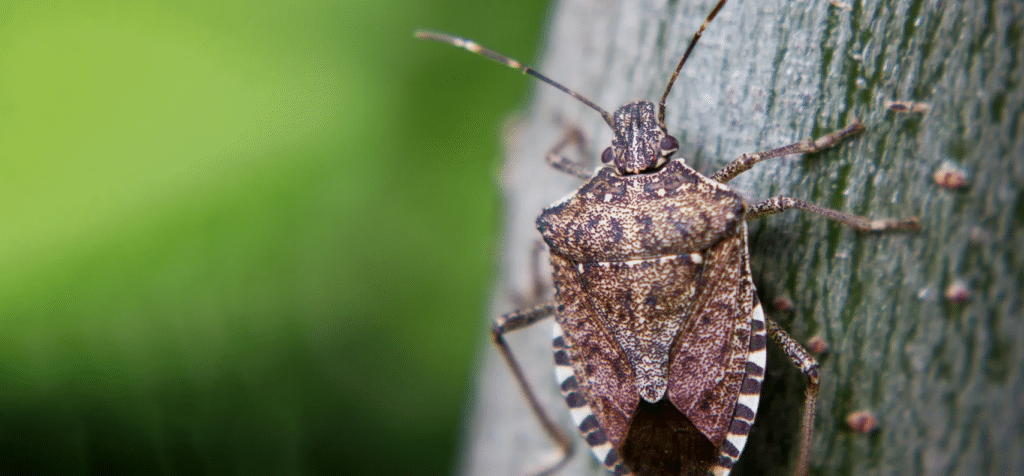
Stink bugs are becoming increasingly prevalent in Michigan and are known for their distinct odor when disturbed or crushed. These shield-shaped insects belong to the family Pentatomidae and are typically brown or mottled in color. While they do not pose any direct harm to humans or pets, their presence can be a nuisance and cause concern for homeowners.
The most common stink bug species found in Michigan is the brown marmorated stink bug (Halyomorpha halys). Originally from Asia, this invasive species has made its way to North America and has become a prominent pest in many regions. They are about three-quarters of an inch long and have a characteristic brown coloration with lighter bands on their antennae and edges of their abdomen.
Stink bugs primarily feed on a wide variety of plants, including fruits, vegetables, and ornamental plants. They use their piercing mouthparts to puncture the plant’s tissues and suck out the juices, causing cosmetic damage to crops and affecting fruit quality. While they are not a significant threat to human health, their presence in large numbers can be a concern for agricultural producers and homeowners alike.
During the cooler months, stink bugs seek shelter indoors to escape the harsh weather conditions. They often find their way inside through small openings and gaps in windows, doors, and foundations. Once inside, they may congregate in attics, wall voids, or other protected areas. When disturbed or threatened, stink bugs release a pungent odor as a defensive mechanism, hence their name.
To prevent stink bugs from entering your home, it’s important to seal any potential entry points. Inspect your home’s exterior for cracks, gaps, and openings and seal them using caulk or weatherstripping. Pay attention to areas around windows, doors, utility penetrations, and vents. Properly maintaining window screens can also help prevent their entry.
If you find stink bugs inside your home, it’s best to handle them carefully or avoid disturbing them to prevent the release of their odor. Using a vacuum cleaner with a hose attachment can be an effective method for removing stink bugs without squashing them.
While stink bugs can be managed using DIY methods, professional pest control services can provide more comprehensive solutions for severe infestations. They can assess the situation, employ targeted treatments, and offer advice on long-term prevention.
Rodents
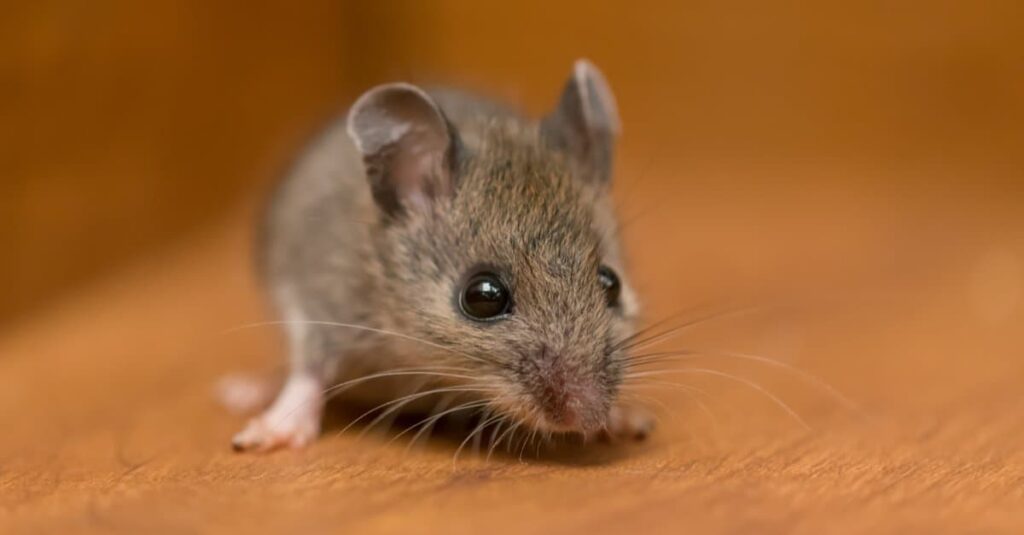
Rodents, such as mice and rats, are common pests that can cause significant damage to homes and pose health risks to humans. In Michigan, several rodent species are prevalent, including house mice, Norway rats, and roof rats. These small mammals have sharp incisors that continuously grow, leading them to gnaw on various materials, including wood, wires, insulation, and food packaging.
Rodents are known to carry and transmit diseases, including salmonellosis, hantavirus, and leptospirosis. They can contaminate food and surfaces with their droppings, urine, and saliva, potentially causing illnesses in humans. Additionally, their gnawing behavior can cause structural damage and electrical fires, posing a threat to the integrity of homes and businesses.
House mice are the most common rodent species found in Michigan. They are small, typically measuring 2.5 to 3.75 inches in length, excluding their tail. They are light brown or gray in color with a slightly pointed snout. House mice are adaptable and can thrive in various environments, making them a nuisance for homeowners. They can fit through tiny openings as small as a dime, allowing them to gain access to homes and buildings easily.
Norway rats, also known as brown rats, are larger than house mice, measuring around 7 to 9.5 inches in length, excluding their tail. They have a stocky build and coarse brown fur. Norway rats prefer to burrow in the ground but can also access buildings through small gaps and damaged foundations. They are skilled climbers and swimmers, further increasing their ability to infiltrate structures.
Roof rats, also called black rats, are similar in size to Norway rats but have a more slender build. They are excellent climbers and are commonly found in attics, roofs, and trees. Roof rats have a black or dark brown coat and are agile jumpers, capable of leaping several feet.
To prevent rodent infestations, it’s crucial to eliminate their access points and address conditions that attract them. Here are some preventive measures:
- Seal any gaps or cracks in your home’s foundation, walls, and windows. Pay close attention to areas where utilities enter the building.
- Install door sweeps and weatherstripping to prevent rodents from entering through gaps under doors.
- Keep your home clean and free of food debris. Store food in airtight containers and promptly clean up spills.
- Regularly inspect and maintain your property, including clearing clutter, trimming vegetation away from the house, and sealing potential entry points.
Bed Bugs
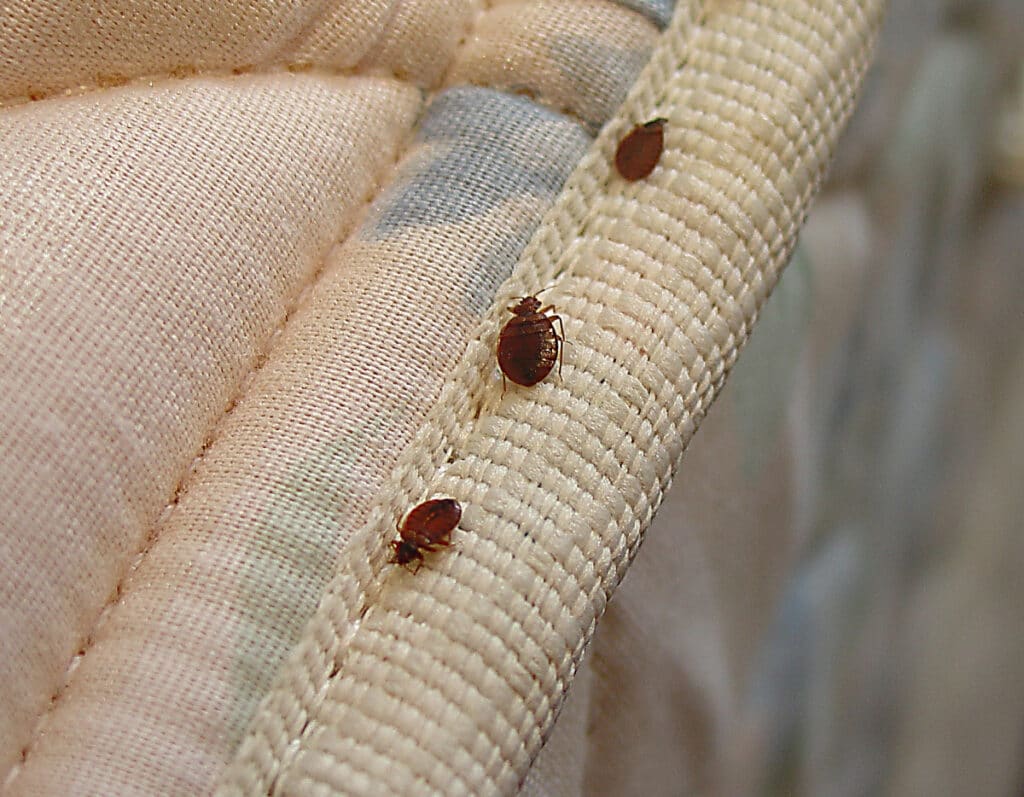
Bed bugs are small, reddish-brown insects that feed on the blood of humans and animals. While they were once nearly eradicated in the United States, bed bug infestations have become increasingly common, including in Michigan. These elusive pests can be found in homes, hotels, dormitories, and other areas where people reside.
Bed bugs are excellent hitchhikers and can easily latch onto luggage, clothing, and other belongings, allowing them to spread from one location to another. They prefer to hide in cracks and crevices near sleeping areas, such as mattress seams, headboards, and baseboards. At night, they emerge to feed on their sleeping hosts, leaving behind itchy, red bite marks.
One of the major challenges with bed bugs is their ability to reproduce rapidly. A single female bed bug can lay hundreds of eggs in her lifetime, leading to a large infestation within a relatively short period. These pests are resilient and can survive for several months without a blood meal, making them difficult to eliminate without professional intervention.
Bed bug bites can cause itching, allergic reactions, and psychological distress due to the associated stigma. If you suspect a bed bug infestation, it’s crucial to take immediate action to prevent the problem from worsening.
Here are some steps to help address bed bugs:
- Inspect your sleeping area: Thoroughly check your mattress, box spring, bed frame, and surrounding furniture for signs of bed bugs. Look for live bugs, shed skins, dark stains (indicating fecal matter), or tiny white eggs.
- Wash and dry infested items: Launder all infested bedding, clothing, and linens in hot water and dry them on the highest heat setting. This will help kill bed bugs and their eggs.
- Vacuum and declutter: Vacuum your mattress, furniture, and carpets to remove bed bugs and their eggs. Pay close attention to seams, cracks, and crevices. After vacuuming, seal the vacuum bag in a plastic bag and dispose of it outdoors.
- Seek professional assistance: Bed bug infestations are challenging to eliminate completely without professional help. Pest control professionals have the expertise, tools, and treatments necessary to effectively eradicate bed bugs.
It’s important to note that DIY bed bug treatments are often ineffective and may even make the infestation worse. Bed bugs have developed resistance to many common pesticides, making professional intervention the most reliable approach.
To prevent bed bug infestations, take precautions when traveling. Inspect hotel rooms for signs of bed bugs before settling in. Keep luggage elevated and away from beds and upholstered furniture. Upon returning home, inspect your belongings and launder clothing immediately.
Yellow Jackets
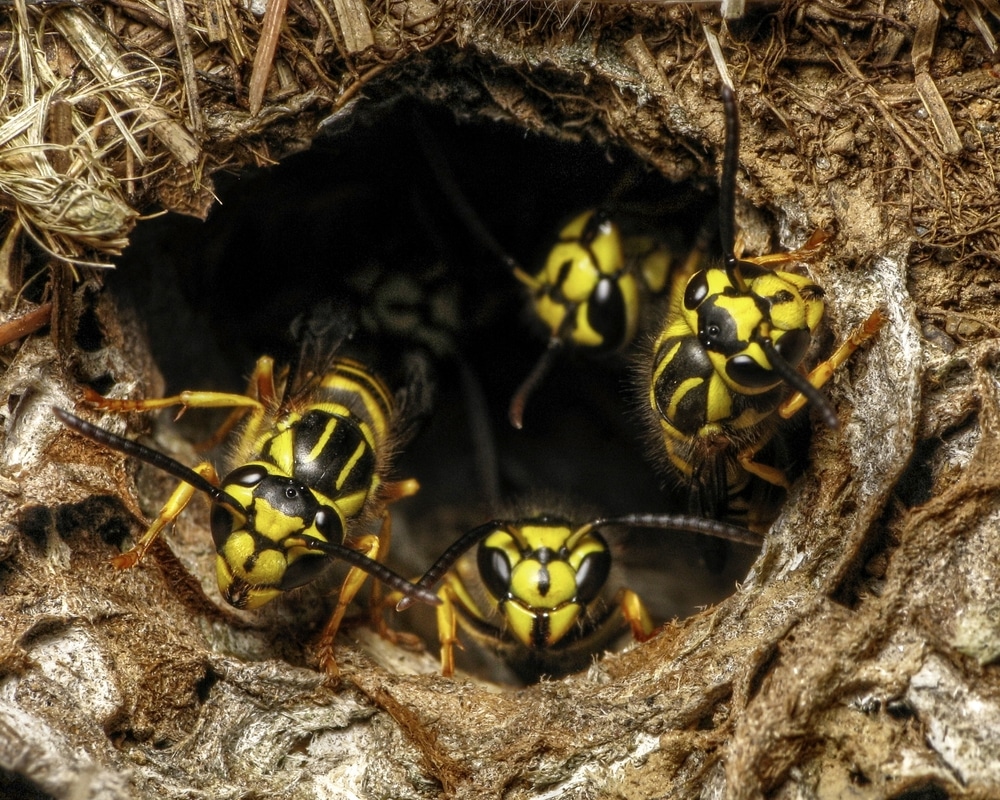
Yellow jackets are aggressive stinging insects that are known for their distinctive yellow and black markings. They belong to the wasp family and are commonly encountered in Michigan, particularly during the warm months. Yellow jackets are social insects that live in colonies, and their nests can be found in various locations, including underground, in wall voids, or in trees and shrubs.
These stinging insects can pose a threat to humans, especially for those who are allergic to their venom. Yellow jackets are known to become defensive when their nests or feeding areas are disturbed, leading to painful stings. Their stingers can cause intense pain, swelling, and allergic reactions in sensitive individuals.
Yellow jackets are opportunistic feeders and are attracted to sugary substances, ripe fruits, and protein sources. This scavenging behavior often leads them into contact with humans, particularly during outdoor gatherings and picnics. They can become aggressive when food is present, making it important to take precautions to minimize their attraction.
If you encounter a yellow jacket nest on your property, it’s crucial to exercise caution and avoid approaching or disturbing it. Attempting to remove or treat the nest without professional knowledge and protective equipment can be dangerous. Instead, it’s recommended to contact a licensed pest control professional who can safely assess the situation and provide appropriate solutions.
To minimize yellow jacket encounters and prevent stings, consider the following preventive measures:
- Cover food and drinks: When dining outdoors, keep food and drinks covered until ready to consume. Yellow jackets are attracted to sweet and protein-rich foods, so keeping them sealed and out of sight can help reduce their presence.
- Proper waste management: Ensure that trash cans and bins have tightly fitting lids. Yellow jackets are attracted to garbage, so maintaining proper sanitation practices can help deter them.
- Seal entry points: Inspect your property for any openings or gaps that could serve as entry points for yellow jackets. Seal cracks in walls, gaps around windows and doors, and any other potential access points.
- Remove attractants: Keep outdoor areas free from fallen fruits, spills, and open containers of food or drinks. Clean up promptly after outdoor activities to minimize potential food sources for yellow jackets.
If you are dealing with a yellow jacket infestation or nest, it’s best to rely on professional pest control services. They have the expertise and protective gear to safely handle and eliminate yellow jacket nests, ensuring the safety of you and your family.
Box Elder Bugs

Box elder bugs are small, dark insects with distinctive red or orange markings on their wings. They are commonly found in Michigan, especially during the cooler months. These insects get their name from their preferred host, the box elder tree, although they can also be found on other trees, shrubs, and buildings.
Box elder bugs are primarily a nuisance pest, as they do not cause structural damage or pose significant health risks to humans. However, their large numbers and tendency to invade homes in search of warmth during the fall and winter months can be bothersome.
During warmer seasons, box elder bugs feed on the leaves, flowers, and seeds of box elder trees, as well as other similar trees and plants. However, as temperatures drop, they seek shelter in protected areas, including cracks and crevices in buildings. They often gather on sun-exposed surfaces, such as walls, windows, and doors, in large numbers, causing concern for homeowners.
While box elder bugs do not bite or sting, their presence can be unsettling, and they may emit a foul odor when disturbed or crushed. This defensive mechanism is a deterrent against predators but is harmless to humans.
To prevent box elder bugs from entering your home, consider the following measures:
- Seal entry points: Inspect your home for gaps, cracks, and openings that may serve as entry points for box elder bugs. Seal any potential entryways, such as gaps around windows and doors, foundation cracks, and utility openings.
- Repair screens: Ensure that window screens are intact and in good condition. Repair or replace damaged screens to prevent box elder bugs from entering through open windows or doors.
- Remove attractants: Box elder bugs are attracted to the box elder tree, as well as other similar trees and plants. If possible, remove any female box elder trees or treat them with appropriate insecticides to deter box elder bug populations in the vicinity of your home.
- Professional treatment: If you’re dealing with a persistent box elder bug problem, it may be beneficial to seek professional pest control services. Pest control professionals have access to targeted treatments and techniques to help manage and reduce box elder bug populations around your property.
It’s important to note that physical removal or squashing box elder bugs inside your home is not recommended, as it can release their odor and attract more of them. Instead, focus on preventive measures and seek professional assistance for effective long-term control.
Cockroaches
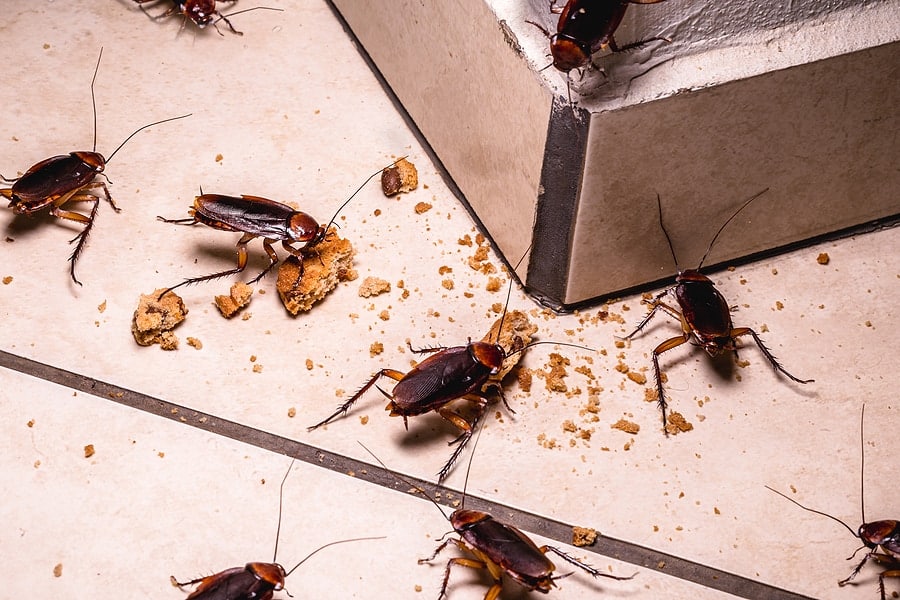
Cockroaches are resilient insects that can be found in various parts of Michigan, particularly in areas with ample food and moisture sources. These nocturnal pests are known for their ability to adapt and survive in diverse environments, making them a persistent nuisance in homes, restaurants, and other buildings.
Cockroaches are attracted to warm and humid spaces, and they seek out areas with access to food and water. They can enter homes through small cracks, gaps, or openings in walls, pipes, and foundations. Once inside, they multiply quickly, posing health risks and causing damage to property.
One of the primary concerns associated with cockroaches is their potential to spread diseases. These pests are known to carry and transmit various pathogens, including bacteria, viruses, and parasites. Cockroach infestations have been linked to the spread of diseases such as salmonella, dysentery, and asthma-related allergies.
Additionally, cockroach allergens can trigger respiratory problems, particularly in individuals with pre-existing conditions such as asthma or allergies. Their shed skins, saliva, feces, and decomposing bodies can become airborne and contaminate indoor air, leading to allergic reactions and respiratory distress.
To prevent and control cockroach infestations, consider the following measures:
- Maintain cleanliness: Cockroaches are attracted to food and moisture sources. Keep your home clean and free of crumbs, spills, and food debris. Regularly clean kitchen countertops, appliances, and dining areas. Ensure that garbage is properly sealed and promptly disposed of.
- Eliminate hiding places: Cockroaches prefer dark and cluttered areas. Declutter your living spaces and minimize hiding spots by sealing cracks and crevices in walls, repairing leaks and drips, and organizing storage areas.
- Seal entry points: Inspect your home for potential entry points, such as gaps around doors, windows, pipes, and utility openings. Seal any openings using caulk or weatherstripping to prevent cockroaches from entering.
- Fix moisture issues: Cockroaches thrive in moist environments. Repair any plumbing leaks and address moisture problems in basements, crawl spaces, and bathrooms. Use dehumidifiers in areas prone to high humidity.
- Professional pest control: If you’re dealing with a persistent cockroach infestation, it’s advisable to seek professional pest control services. Pest control professionals have the knowledge, experience, and effective treatments to eradicate cockroaches and implement preventive measures.
It’s important to take cockroach infestations seriously and address them promptly to minimize health risks and property damage. Early detection and intervention are key to preventing their population from growing and spreading.
Fleas
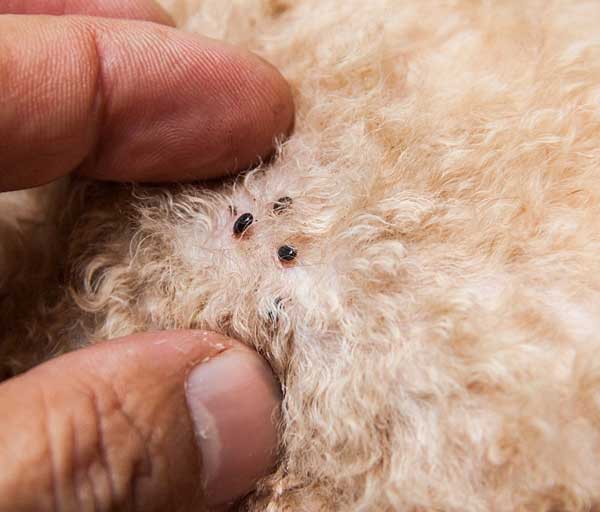
Fleas are small, wingless insects that are notorious for their ability to infest pets and homes. While fleas are commonly associated with pets like dogs and cats, they can also be found in Michigan’s outdoor environments, particularly in areas where wildlife and domesticated animals frequent.
Fleas are ectoparasites that feed on the blood of mammals and birds. They have strong legs that enable them to jump onto their hosts, allowing them to move from one host to another quickly. Flea bites can cause significant discomfort and itching, and some individuals may develop an allergic reaction to their saliva.
Pets can easily pick up fleas when they come into contact with infested areas or other animals carrying fleas. Once inside a home, fleas can quickly establish an infestation, laying eggs in carpets, bedding, and furniture. This makes flea control challenging and requires a comprehensive approach.
Beyond the itchy bites they cause, fleas can pose serious health risks. Fleas are known vectors for various diseases and parasites. They can transmit diseases to both animals and humans, including murine typhus, cat scratch disease, and certain types of tapeworms. Additionally, severe infestations can lead to anemia, especially in young or small animals.
To prevent and control fleas, consider the following measures:
- Regular pet grooming: Maintain regular grooming practices for your pets, including bathing and brushing. This helps to remove any adult fleas and their eggs, reducing the chances of infestation.
- Flea control for pets: Consult with your veterinarian about appropriate flea control products for your pets. There are various options available, including spot-on treatments, oral medications, and flea collars. Regularly treat your pets according to the recommended schedule to prevent fleas from infesting them and your home.
- Vacuum frequently: Regularly vacuum your home, paying close attention to areas where pets spend the most time. This helps to remove flea eggs, larvae, and pupae from carpets, rugs, and furniture. Dispose of the vacuum bag or empty the canister outside to prevent reinfestation.
- Wash bedding and fabrics: Wash pet bedding, cushions, and any fabrics that may have come into contact with fleas on a hot water cycle. This helps to kill fleas and their eggs.
- Outdoor flea control: If you have a yard or outdoor space, consider treating it for fleas, especially in areas where pets spend time. Consult with a professional pest control service for effective outdoor flea control solutions.
- Professional pest control: In cases of severe infestation or if your efforts are not yielding satisfactory results, it may be necessary to seek professional pest control services. Pest control professionals have the expertise and knowledge to identify and implement effective flea control strategies.
Flies
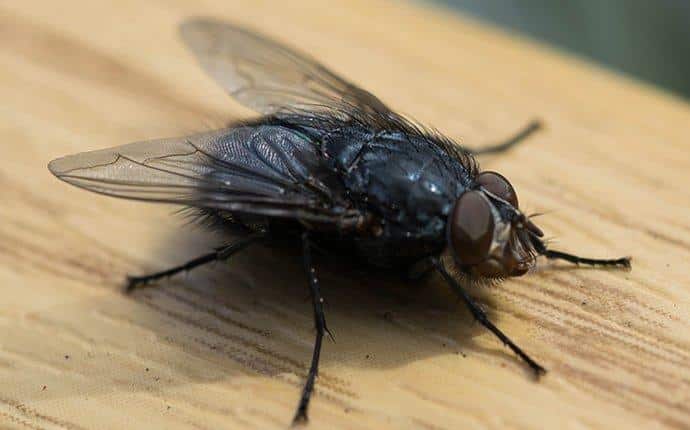
Flies are common pests found throughout Michigan and can be a significant nuisance, both indoors and outdoors. They are known for their ability to quickly reproduce and their attraction to various food sources. Flies can carry and transmit disease-causing pathogens, making them a potential health hazard.
There are different types of flies commonly found in Michigan, including house flies, fruit flies, and blow flies. Each type has its own behavior and preferences, but they all share certain characteristics that make them pests of concern.
House flies are attracted to decaying organic matter and can be found around garbage bins, food preparation areas, and animal waste. They are known to carry various disease-causing organisms, such as bacteria and viruses, which can contaminate food and surfaces, potentially leading to illnesses like diarrhea and food poisoning.
Fruit flies are small, flying insects that are attracted to overripe fruits, fermenting foods, and sugary substances. They can quickly infest kitchens, pantries, and areas where fruits and vegetables are stored. While they are not known to transmit diseases, they can contaminate food and become a nuisance.
Blow flies, also known as bluebottle flies or greenbottle flies, are attracted to decaying animal carcasses and feces. They lay their eggs in these organic materials, and their larvae, commonly referred to as maggots, feed on the decaying matter. Blow flies can also be found around garbage bins and pet waste.
To prevent and control fly infestations, consider the following measures:
- Proper sanitation: Maintain cleanliness and proper sanitation practices in and around your home. Keep garbage bins tightly sealed, clean up food spills and crumbs promptly, and regularly remove pet waste from your yard. By eliminating potential food sources, you can reduce fly attraction.
- Screening and sealing: Install screens on doors and windows to prevent flies from entering your home. Inspect your home for gaps, cracks, and openings that flies can use as entry points. Seal any openings and repair damaged screens to prevent flies from gaining access.
- Proper food storage: Store fruits, vegetables, and other perishable foods in sealed containers or in the refrigerator. Avoid leaving food uncovered, and promptly clean up spills or food debris to minimize fly attraction.
- Traps and baits: Consider using fly traps or baits to capture and control adult flies. There are various types available, including sticky traps, flypaper, and insect light traps. Follow the manufacturer’s instructions for placement and usage.
- Professional pest control: In cases of severe fly infestations or if your efforts are not yielding satisfactory results, it may be necessary to seek professional pest control services. Pest control professionals have access to specialized treatments and techniques to effectively eliminate flies and implement long-term prevention strategies.
Ladybugs
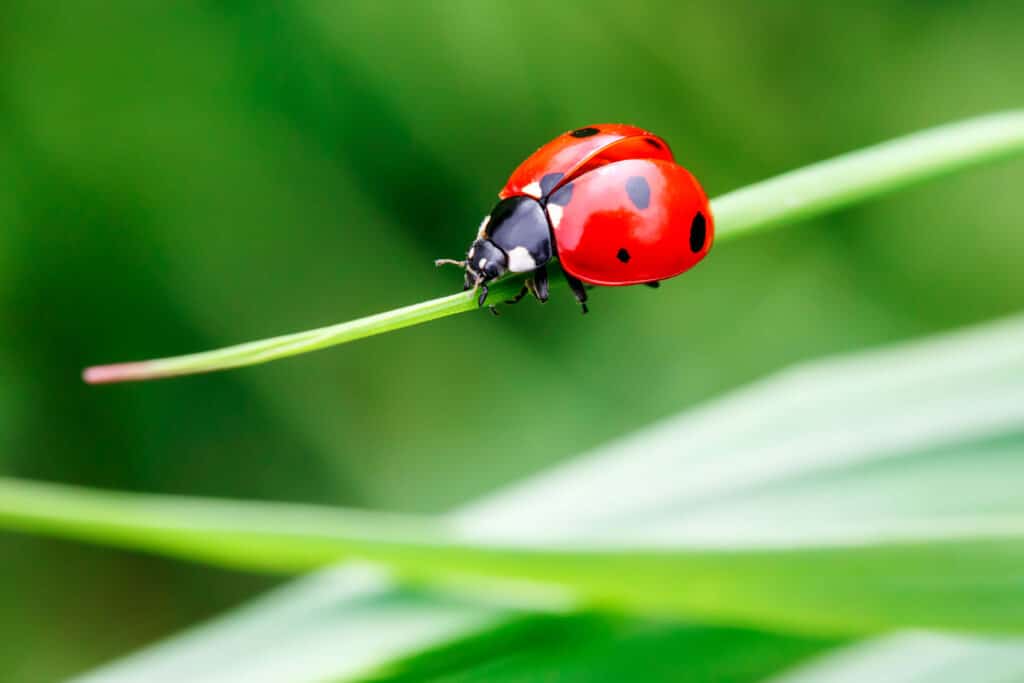
Ladybugs, also known as lady beetles or ladybirds, are small, colorful insects that are generally considered beneficial due to their role in controlling other pest populations. In Michigan, ladybugs are commonly found in gardens, agricultural fields, and around residential areas.
Ladybugs are known for their distinctive rounded shape and bright colors, typically red or orange with black spots. While they are generally considered beneficial, certain species of ladybugs can become a nuisance when they invade homes in large numbers, seeking shelter during the colder months.
During the warmer months, ladybugs feed on aphids, scale insects, and other soft-bodied pests that can damage plants and crops. They help control these pest populations naturally, making them valuable allies for gardeners and farmers. Ladybugs are also known to feed on mites, mealybugs, and small caterpillars.
However, when temperatures drop, ladybugs seek shelter in protected areas, including homes and buildings. Large congregations of ladybugs can accumulate in wall voids, attics, and other secluded spaces, which can become problematic for homeowners. Ladybugs do not cause structural damage or pose significant health risks, but their presence in large numbers can be a nuisance, especially when they release a defensive odor.
To prevent and manage ladybug invasions, consider the following measures:
- Seal entry points: Inspect your home for potential entry points and seal any gaps or cracks. Pay attention to areas around windows, doors, vents, and utility openings. Use weatherstripping, caulk, or other appropriate materials to seal these entry points and prevent ladybugs from gaining access.
- Install screens: Install fine mesh screens on windows, vents, and openings to prevent ladybugs from entering your home while still allowing for proper ventilation.
- Remove attractants: Ladybugs are attracted to light-colored surfaces, especially when illuminated at night. Consider switching to yellow or orange outdoor lighting, which is less attractive to ladybugs. Additionally, consider removing exterior light sources that are in close proximity to entry points.
- Vacuum or sweep: If ladybugs have already entered your home, use a vacuum cleaner or broom to remove them. Avoid squishing or crushing them, as they may release an odor. Dispose of captured ladybugs outside or in a sealed bag.
- Professional pest control: If ladybug infestations become overwhelming or persistent, it may be necessary to seek professional pest control services. Pest control professionals can assess the situation, provide targeted treatments, and implement preventive measures to manage ladybug invasions effectively.
While ladybugs are generally considered beneficial insects, their large congregations indoors can be a nuisance.
Mosquitos
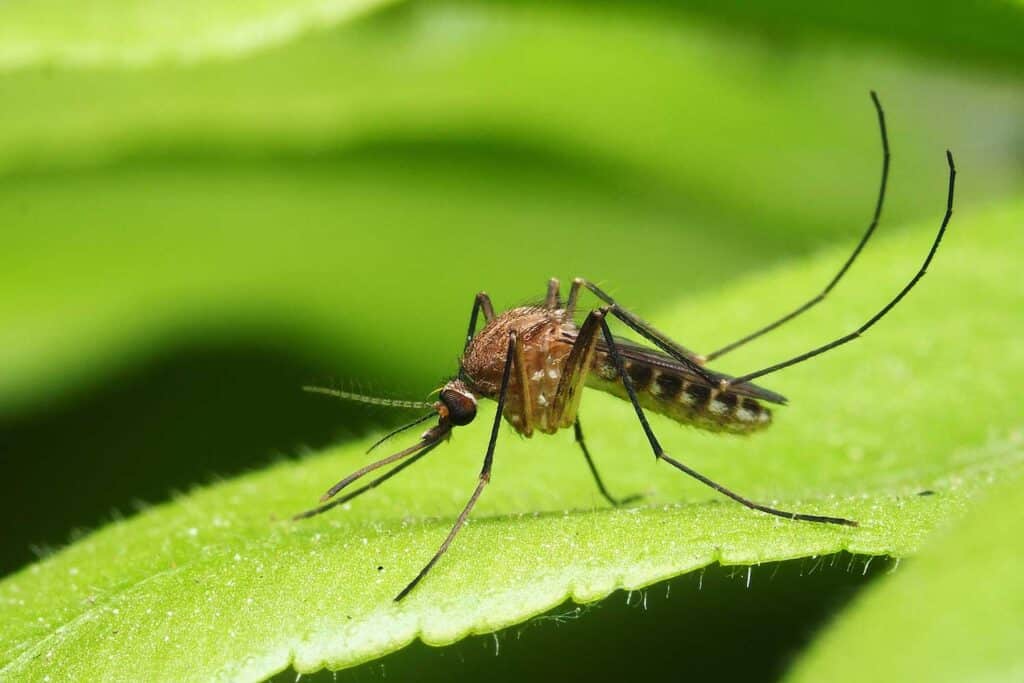
Mosquitoes are notorious pests that can be found in abundance throughout Michigan, particularly during the warmer months. These small, flying insects not only cause itchy bites but also pose a significant health risk as they are known to transmit diseases.
In Michigan, the most common mosquito species include the northern house mosquito (Culex pipiens), the eastern treehole mosquito (Aedes triseriatus), and the northern floodwater mosquito (Aedes vexans). These species thrive in various habitats, including urban areas, wooded regions, and near bodies of water such as lakes, ponds, and marshes.
One of the primary concerns with mosquitoes is their ability to transmit diseases to humans and animals. In Michigan, mosquitoes are known to carry diseases such as West Nile virus, Eastern equine encephalitis (EEE), and La Crosse encephalitis. These diseases can cause severe symptoms and, in some cases, even lead to long-term health complications or fatalities.
To protect yourself and your family from mosquito-borne diseases, it is crucial to take preventive measures. Consider the following steps:
- Eliminate breeding sites: Mosquitoes lay their eggs in stagnant water. Regularly inspect your property for any standing water sources and eliminate them. Empty and clean birdbaths, flowerpots, buckets, and any other containers that can collect water. Keep gutters clean and ensure proper drainage.
- Use repellents: Apply mosquito repellents containing DEET, picaridin, or oil of lemon eucalyptus on exposed skin to deter mosquitoes. Follow the instructions on the product label for safe and effective use. Wear long-sleeved shirts, long pants, and socks when spending time outdoors, especially during dawn and dusk when mosquitoes are most active.
- Install screens: Ensure that windows and doors have tight-fitting screens to keep mosquitoes out of your home. Repair any damaged screens to prevent mosquito entry.
- Reduce outdoor exposure: When mosquitoes are particularly active, limit your outdoor activities, especially in areas with high mosquito populations. Consider rescheduling outdoor events or choose locations that are away from stagnant water sources.
- Mosquito control treatments: Consider professional mosquito control treatments for your property. These treatments can target mosquitoes at different life stages, reducing their population and minimizing the risk of bites and disease transmission. A licensed pest control provider can assess your property, identify potential breeding sites, and apply targeted treatments.
By implementing these preventive measures, you can reduce the presence of mosquitoes around your home and lower the risk of mosquito-borne diseases. It’s important to stay vigilant and take necessary precautions to protect yourself and your loved ones from the potential health hazards associated with mosquitoes.
Termites
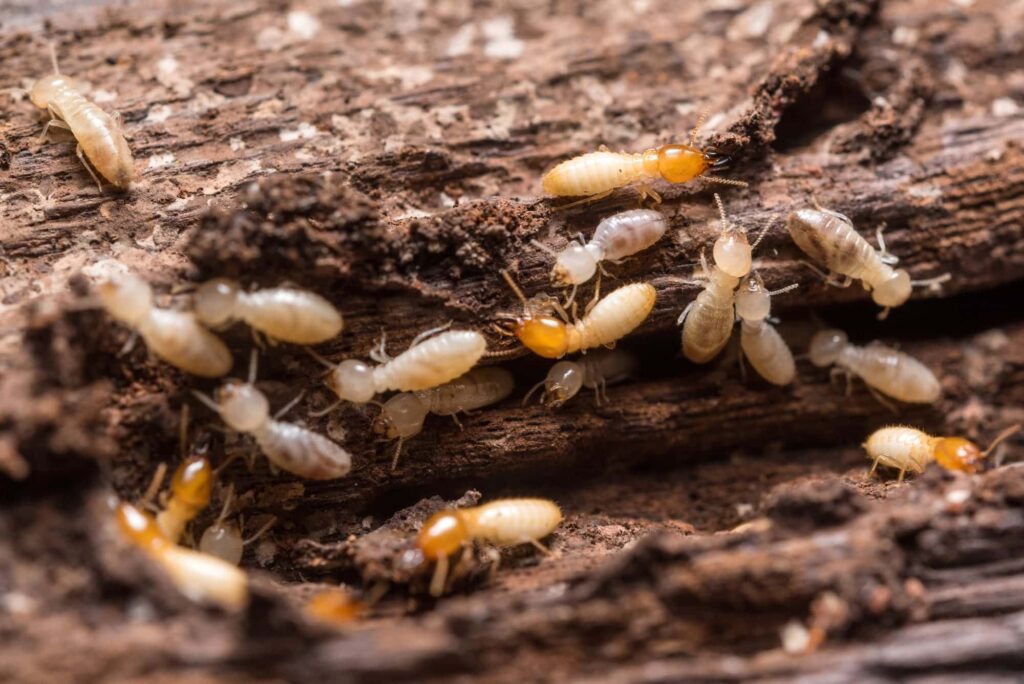
Termites are silent destroyers that can cause significant damage to structures and wooden components of buildings. In Michigan, the most common termite species are subterranean termites, which live in underground colonies and build mud tubes to access above-ground food sources.
These pests feed on cellulose material found in wood, paper, and other plant-based products. They can infest both residential and commercial properties, posing a serious threat to the structural integrity of buildings. Termites are often referred to as “hidden invaders” because their activities can go unnoticed until extensive damage has already occurred.
One of the biggest challenges with termite infestations is their ability to remain undetected for long periods. They usually work from the inside out, hollowing out wooden structures without showing any visible signs on the surface. This makes early detection and professional intervention crucial in managing termite problems.
To protect your property from termites and minimize the risk of damage, consider the following measures:
- Regular inspections: Schedule regular inspections by a licensed pest control professional to check for signs of termite activity. Professionals are trained to identify subtle signs such as mud tubes, discarded wings, and damaged wood.
- Moisture control: Termites thrive in moist environments. Keep your property well-maintained and address any moisture issues promptly. Repair leaking pipes, ensure proper drainage around the foundation, and remove any standing water sources near the building.
- Remove wood-to-soil contact: Termites can easily access buildings through direct contact between wood and soil. Avoid burying wooden structures or allowing wooden components to come into direct contact with the soil. Use concrete or metal barriers to separate wood from the ground.
- Store wood properly: If you have firewood or wooden materials stored on your property, keep them elevated and away from the main structure. Regularly inspect stored wood for signs of termite activity.
- Professional termite treatments: Consider preventive termite treatments for your property. Professional pest control providers offer various treatment options, including soil treatments, baiting systems, and wood treatments, to prevent termite infestations and protect your property from damage.
It’s important to take termite infestations seriously, as untreated infestations can lead to significant structural damage and costly repairs. By being proactive and working with a professional pest control provider, you can detect termite activity early and implement appropriate measures to safeguard your property.
Ticks

Ticks are small arachnids that feed on the blood of humans and animals. In Michigan, ticks are commonly found in wooded areas, grassy fields, and even in residential areas with tall grass and vegetation. They are particularly active during the warmer months, from spring to fall.
Ticks are known to transmit diseases such as Lyme disease, anaplasmosis, babesiosis, and Powassan virus, among others. These diseases can cause serious health complications if left untreated. It is important to take preventive measures and be aware of the risks associated with tick bites.
To protect yourself and your family from tick-borne diseases, consider the following steps:
- Wear protective clothing: When venturing into tick-prone areas, wear long-sleeved shirts, long pants tucked into socks, and closed-toe shoes. Light-colored clothing makes it easier to spot ticks. Consider treating your clothing with permethrin, an insect repellent that can be sprayed on clothing and shoes for added protection.
- Use tick repellents: Apply an EPA-approved tick repellent on exposed skin. Look for products containing DEET, picaridin, or oil of lemon eucalyptus. Follow the instructions on the product label for safe and effective use.
- Perform regular tick checks: After spending time outdoors, thoroughly check your body for ticks. Pay close attention to areas such as the scalp, neck, armpits, groin, and behind the ears. If you find a tick attached to your skin, carefully remove it using fine-tipped tweezers, grasping it as close to the skin as possible. Clean the bite area with antiseptic.
- Create a tick-safe environment: Reduce tick habitat around your property by keeping lawns well-maintained, clearing leaf litter, and trimming vegetation. Create a barrier between wooded areas and recreational spaces, such as playgrounds or patios, using gravel or wood chips.
- Protect your pets: Use tick preventatives on your pets to reduce the risk of tick infestations in your home. Consult with your veterinarian for the most appropriate tick control methods for your pets.
- Professional pest control: Consider professional tick control services for your property. Pest control professionals can assess your property, identify tick habitats, and provide targeted treatments to reduce tick populations. They may also recommend additional measures, such as creating tick barriers or applying acaricides to vegetation.
By following these preventive measures, you can minimize the risk of tick bites and the potential transmission of tick-borne diseases. Stay informed about the prevalence of ticks in your area and take appropriate precautions when spending time in tick-prone environments.
Conclusion
Michigan is home to a diverse range of pests that can pose threats to both residential and commercial properties. Understanding the common pests in the region, their dangers, and effective prevention methods is essential for protecting your property and maintaining a safe and healthy environment for you, your family, and your employees.
By implementing proactive pest control measures and seeking professional assistance when needed, you can mitigate the risks associated with these pests and prevent potential infestations. Remember, prevention is key when it comes to pest control. Regular inspections, proper sanitation, and prompt action are the cornerstones of effective pest management.
It’s important to stay vigilant and address pest problems promptly to avoid further damage, health risks, and costly repairs. Whether it’s ants, powder post beetles, carpet beetles, centipedes, earwigs, clover mites, spiders, stink bugs, rodents, bed bugs, yellow jackets, box elder bugs, cockroaches, fleas, flies, ladybugs, mosquitos, termites, ticks, or any other common pest, understanding their behaviors, habitats, and vulnerabilities is crucial for successful pest control.
We at Prevent Pests are dedicated to providing comprehensive and effective pest control solutions for residential and commercial properties in Michigan. Our team of trained professionals understands the unique pest challenges faced by homeowners and businesses in the area. With our expertise and state-of-the-art pest control techniques, we are committed to ensuring your property remains pest-free and your peace of mind is restored.
Remember, when it comes to pest control, prevention is always better than cure. Regular inspections, proper sanitation practices, and proactive measures are essential in keeping pests at bay. However, if you find yourself facing a pest infestation, don’t hesitate to contact our team at Prevent Pests. We have the knowledge, experience, and tools to address any pest problem effectively and efficiently.
We value your safety, health, and satisfaction, and we are dedicated to providing exceptional customer service. Our goal is to establish long-term relationships with our clients by delivering reliable and tailored pest control solutions.
Don’t let pests take control of your home or business. Take the necessary steps to protect your property, your loved ones, and your peace of mind. Reach out to Prevent Pests today and let us be your trusted partner in creating a pest-free environment.
Remember, prevention is key, and with Prevent Pests, you can safeguard your property and enjoy a pest-free lifestyle.
Note: We hope this comprehensive guide has provided you with valuable insights into the most common pests found in Michigan, their dangers, and effective prevention methods. For more information and personalized pest control solutions, feel free to reach out to our team at Prevent Pests. We are here to assist you and address any concerns you may have.

